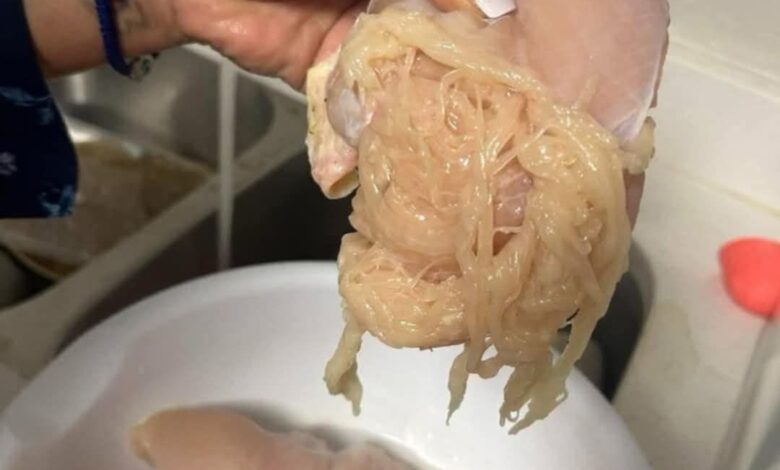The Surprising Truth About Modern Poultry: When Chicken Breast Resembles Pasta

Consumers are questioning food quality after a Texas mother’s shocking discovery during meal preparation
A mother in Texas made an unsettling discovery while preparing dinner for her family: raw chicken breast that separated into stringy, spaghetti-like strands. The peculiar transformation occurred despite pasta not being on the menu that evening.
Mother’s Viral Food Safety Concern Sparks Online Discussion
Alesia Cooper from Irving, Texas shared her experience on Facebook on March 21, posting a photo that quickly captured widespread attention.
“I been debating on posting this but since I had to see it so do you all,” Cooper wrote alongside the disturbing image showing chicken breast breaking apart into pasta-like strands. “I was cooking my kids dinner a couple of weeks ago and was cleaning my meat like I normally do and when I went back to start cooking it turned into this.”
The mother of two mentioned she purchased the chicken breast from Aldi, a budget-friendly supermarket chain. Her post concluded with genuine concern: “I think it’s that alternative meat but I’m not sure anyways… I ain’t made chicken off the bone since.”
Consumer Reactions and Food Quality Concerns
The post quickly generated numerous comments from concerned individuals offering various explanations for the unusual chicken texture:
“That’s laboratory-developed chicken, it’s a new production method created because of recent avian influenza outbreaks and resource shortages that limited production. Last year they announced they found a way to produce chicken in laboratory conditions and that’s what’s in stores now,” one commenter suggested.
Another simply stated: “Genetically modified laboratory meat.”
A third commenter expressed: “It’s not authentic. I don’t purchase it anymore.”
However, one response offered a more evidence-based explanation: “It’s not laboratory-developed meat or artificially created meat. It comes from real chickens. The issue stems from poultry producers administering growth hormones to chickens, forcing them to grow at an unnaturally accelerated rate.”
Understanding “Spaghetti Meat” in Modern Poultry Production
According to reporting by The Wall Street Journal, along with tough, chewy meat referred to as “woody breast,” the condition known as “spaghetti meat” likely results from breeding practices designed to produce chickens with larger breasts that grow more rapidly.
This approach yields more meat per bird, increasing profit margins for producers.
“There is evidence that these abnormalities correlate with rapid-growth breeding practices,” explains Dr. Massimiliano Petracci, a professor of agriculture and food science at the University of Bologna in Italy, in a statement to the WSJ.
While terms like “woody breast” and “spaghetti meat” might sound concerning, industry experts maintain these conditions don’t pose health risks to consumers.
However, animal welfare advocates note these conditions adversely affect the chickens themselves, whose unnaturally large bodies often become too heavy for their legs to support properly.
The Evolution of Broiler Chickens: A Historical Perspective
Statistics from the National Chicken Council reveal significant changes in broiler chickens – those raised specifically for meat production. In 2000, the average chicken reached market age at 47 days old, weighing 5.03 pounds. By 2023, while still reaching market at 47 days, these birds now weigh substantially more – averaging 6.54 pounds.
For historical context, in 1925, broiler chickens required 112 days to reach a market weight of just 2.5 pounds.
These dramatic changes reflect evolving consumer preferences, particularly the increasing demand for white meat throughout the past century. This shift has motivated the poultry industry to develop chickens with “proportionally larger breasts.”
Consumer Demand Drives Industry Practices
Dr. Michael Lilburn, a professor at Ohio State University’s Poultry Research Center, explained to the Washington Post: “If chicken consumption continues to increase, we’ll likely need even larger chickens. We’ll need to increase the proportion of breast meat in each bird as well.”
“What many people fail to recognize is that consumer demand is driving these industry adaptations,” Lilburn noted, referencing widespread appetite for affordable chicken products including nuggets, wings, and sandwiches. “A relatively small but vocal minority is raising legitimate questions. However, the majority of American consumers remain unconcerned about food sourcing as long as products remain affordable.”
Understanding Modern Food Production
This unusual chicken phenomenon highlights important questions about modern food production methods, consumer awareness, and the consequences of prioritizing quantity and cost over other considerations. As consumers become more informed about their food sources, conversations about sustainable and ethical production practices continue to gain importance in public discourse.
For those concerned about meat quality, nutrition experts recommend purchasing from reputable sources, inspecting meat carefully before cooking, and properly storing and cooking poultry to ensure food safety.